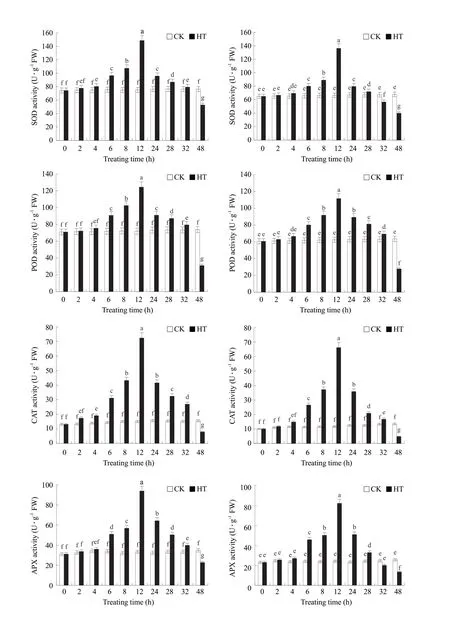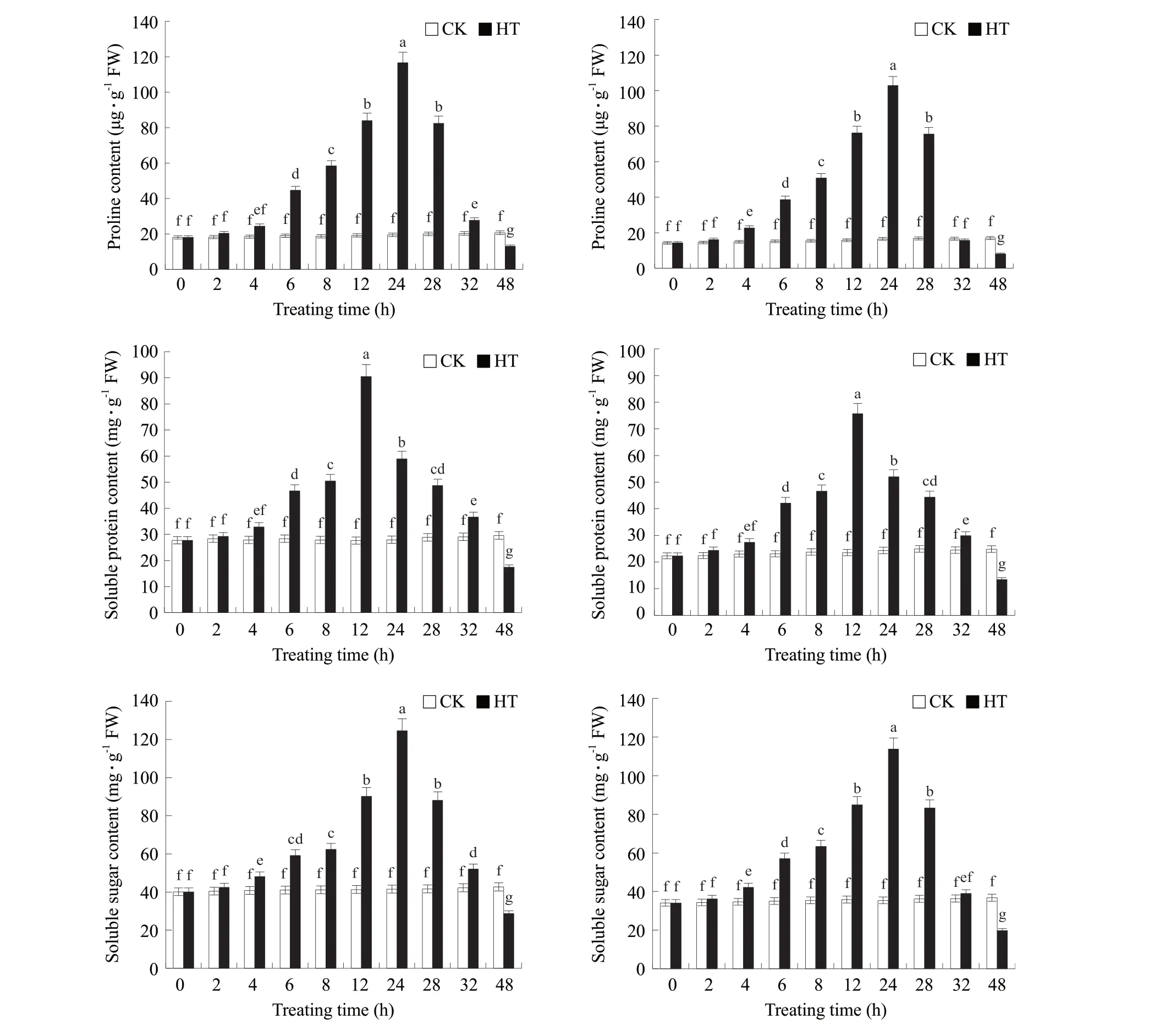Physiological Response of Spring Soybean Seedlings Under Hightemperature Stress
2021-10-21DongShoukunHouXiaominWangXiyueWuZihaoMaZezhongLiShuangandLiuLijun
Dong Shou-kun, Hou Xiao-min, Wang Xi-yue, Wu Zi-hao, Ma Ze-zhong, Li Shuang, and Liu Li-jun
College of Agriculture, Northeast Agricultural University, Harbin 150030, China
Abstract: To understand the response characteristics of soybean seedling resistance systems to high-temperature stress, the spring soybean varieties HN44 and HN65 were selected in this study as the experimental materials, as they had substantial differences in stress resistance.Soybean physiological status was studied under high-temperature stress.Sand culture was used in the experiment, and soybeans at the seedling stage were treated with high-temperature stress.The results showed that the activity of antioxidases and osmotic regulatory substance contents in soybean increased under high-temperature treatment for a certain period of time, the activity of antioxidases and osmotic regulatory substance contents decreased after continuous treatment, and high temperatures continuously increased malondialdehyde contents in the two varieties.At high temperatures, the antioxidant activity and osmotic regulator contents of HN44 were higher than those of HN65, and the malondialdehyde contents of HN44 were higher than those of HN65.The above results showed that HN44 soybeans exhibited significantly higher resistance to high-temperature stress than HN65 variety.
Key words: soybean, high-temperature stress, antioxidase, osmotic regulatory substance
Introduction
Due to human activities and burning of fossil fuels, global carbon dioxide contents have increased, and the climate has warmed.According to authoritative reports, global temperatures are rising, and more hot days now occur in summer (Shen and Wang, 2013).Related studies show that the average annual temperatures in northeast China have risen by 0.327℃/10 a (Xianget al., 2015).Soybean is an important grain and cash crop in China, and the northeast region in China is an important soybeanproducing area.Soybean seeds have high protein and lipid contents and high nutritional and application values (Zhaet al., 2018).At high temperatures, plant development and growth parameters, such as seed germination, propagation and soybean yield, are affected.High temperatures result in burning of stems, petioles, leaves and other soybean organs, wilting of leaves, incomplete growth and development of plant nutrients, and lower ultimate yields.Therefore, it is necessary to study soybean responses to high-temperature stress (Tuet al., 2013).
When plants are subjected to stress, one of the main consequences is the formation of excessive reactive oxygen species (Hasanuzzamanet al., 2013).When high-temperature stress reaches a certain level, the dynamic balance between reactive oxygen species and antioxidant capacity in plants is destroyed and results in the accumulation of reactive oxygen species and ultimately results in plant damage (Munné-Bosch and Alegre, 2002).Antioxidases play an important role in antioxidant activity.When there are more antioxidases in plants, more reactive oxygen species can be removed and plants have greater protection from harm.High-temperature stress can cause dehydration of plant cells, reduce the material transport and synthesis efficiency of plants, and damage the capacity of plants to absorb water.Increases in osmotic adjustment substances can effectively regulate the infiltration of vacuoles in cells and increase plant capacities to absorb and utilize water, which protect plants from being damaged (Luo, 2014).
In this experiment, two soybean varieties with different resistances, HeiNong44 (HN44) and HeiNong65 (HN65), were used as experimental materials to study the change trends of antioxidases, osmotic adjustment substances and malondialdehyde in soybean under high-temperature stress to provide a theoretical foundation for the studies of soybean characteristics with respect to their resistances to high temperatures.
Materials and Methods
Test materials and design
HN44 variety with good drought resistance and HN65 variety with poor drought resistance were selected from the varieties that were widely used for soybean production in Heilongjiang Province (Wanget al., 2012).
In 2018, this experiment was carried out in a glass canopy of Northeast Agricultural University by placing river sand in buckets for cultivation.Plastic buckets with upper diameters of 15 cm, lower diameters of 10 cm and heights of 12 cm were selected.The bottoms of the plastic buckets were covered with gauze.After being cleaned with water, 2 kg of river sand was placed into each bucket.Similar seeds of high quality were sowed, excess seedlings were removed during the seeding stage, and retained three plants in each bucket.After the paired true leaves opened completely, the nutrient solution (Table 1) was added once each day at 8:00 a.m.and 5:00 p.m.(200 mL every time).When seedings with three leaves on the main stem grew fully, all were placed in buckets in the phytotron (e.g., a light cycle of 16 h during the day with an air temperature of 25℃ and 8 h of night with a temperature of 20℃ and relative humidity of 70%) to cultivate for 48 h, this group was treated as a control (CK); then seedings in the same seedling phytotron were subjected to high-temperature (HT) processing, during which the temperature of the phytotron was set to 40℃ during the daytime and 20℃ during night, and the light cycle was set to light for 16 h and darkness for 8 h, while the relative humidity was set to 70%.The values of these parameters for the control group phytotron were the same as before.It could be sampled at time points of 0, 2, 4, 8, 12, 24, 28, 32 and 48 h, the second and the third downward leaves were harvested, and they were put into liquid nitrogen for freezing, the phenotypes of seedlings were observed and this procedure was repeated five times for each sampling location.

Table 1 Composition of nutrient solution
Measurement methods
Proline (Pro) concentrations were determined by the acid ninhydrin method, soluble sugar concentrations were determined by the anthranone method, and soluble protein concentrations were determined by the coomassie brilliant blue method (Zhanget al., 2017).Superoxide dismutase (SOD), peroxidase (POD), catalase (CAT) and ascorbate peroxidase (APX) concentrations were determined with kits obtained from the Suzhou Keming Company.
Malondialdehyde (MDA) concentrations were determined by a colorimetric method (Wanget al., 2014).
Processing and data analyses
Data were processed and analyzed by Excel 2007 and SPSS 17.0 (Microsoft, USA and International Business Machines Corporation, USA).
Results
Effects of high temperatures on antioxidase activity
As shown in Fig.1, in the early stage of stress, with extension of the duration of the high-temperature treatment, changes in antioxidant activity were not significant compared with the control group, indicated that high-temperature stress had a weak effect on soybean antioxidant activities within 4 h after treatment.After 4 h of treatment, antioxidant activity began to increase rapidly, and this activity reached a maximum value after 12 h.As the high-temperature treatment continued, the antioxidant activity of the treatment group began to rapidly decrease.At 48 h of processing, the two varieties reached their lowest values, and the activity for the treatment group was significantly less than that of the control group (p<0.01).When the processing time was 48 h, compared with the control group, for HN44 and HN65 treatment groups, SOD activities decreased by 30.91% and 41.07%, respectively; POD activities decreased by 57.95% and 56.32%, respectively; CAT activities decreased by 49.49% and 69.37%, respectively; and APX activities decreased by 18.85% and 15.70%, respectively.

Fig.1 Antioxidant activities of two varieties in treatment group and control group for different durations of high-temperature stress
At all the points during the processing treatment, HN44 activities were higher than those of HN65, and HN44 exhibited better oxidation resistance than HN65 under high-temperature stress.
Effects of high temperatures on contents of osmotic regulating
Fig.2 showed that as the high-temperature treatment proceeded, the contents of the osmotic adjustment substances exhibited an upward trend that was followed by a downward trend.In the first 4 h of processing, the contents of the osmotic regulation substances did not change significantly and increased only after 4 h of processing.The treatment and control groups exhibited significant differences at other time points (p<0.01).The proline and soluble sugar contents in the treatment group reached their maximum values at 24 h of treatment.Compared to the control group, when the proline and soluble sugar contents reached their maximum values, the proline contents in HN44 and HN65 samples increased by 599.76% and 623.73%, respectively, and the soluble sugar contents increased by 300.17% and 321.56%, respectively.

Fig.2 Contents of osmotic modulating substances for two varieties in treatment group and control group under different durations of high-temperature stress
The soluble protein contents in the treatment group reached a maximum at 12 h of processing.Compared with the control group at this time, the soluble protein contents of HN44 and HN65 samples increased by 228.00% and 221.93%, respectively.After 48 h of high-temperature stress, the proline, soluble protein and soluble sugar contents for HN44 and HN65 were significantly lower than those of the control group (p<0.01).The osmotic regulator contents of HN44 were higher than those of HN65 at all the time points.
Membrane lipid peroxidation induced by high temperatures
As shown in Fig.3, MDA contents of the control HN44 and HN65 groups were stable throughout the treatment process.However, MDA contents for the treatment group generally increased, and MDA contents for the treatment group were greater than those for the control group during the whole treatment process.Within 4 h of high-temperature treatment, MDA contents of the treatment group increased less.As processing continued, MDA contents of the treatment group increased significantly at the last slots and were significantly higher than those of the control group (p<0.01).

Fig.3 Malondialdehyde contents of two varieties in treatment group and control group for different durations of hightemperature stress
Discussion
For the case of antioxidases, some studies had shown that antioxidases were significantly affected in the temperature range from 0℃ to 50℃.CAT, SOD and APX activities increased in a temperaturedependent manner (Chakrabortyand Pradhan, 2011).The results showed that the antioxidase activity in soybean increased under high-temperature stress.After reaching the maximum value, the balance between the antioxidase activity and production of reactive oxygen was destroyed, cells were damaged, and the antioxidase activity gradually decreased.When the duration of high-temperature stress reached 48 h, the antioxidant activity of the treatment group was significantly weaker than that of the control group.Relevant studies on tobacco showed that the antioxidant system was enhanced after shortterm high-temperature stress.In contrast, long-term treatment (tobacco) for 3-5 days resulted in decreased CAT and APX activities, which were lower than those of the control group (Sgobbaet al., 2015).The results of Sgobba's experiment were consistent with our study.In the process of biological evolution, all the kinds of organisms had developed corresponding antioxidant mechanisms to deal with the harm caused by reactive oxygen species (Duet al., 2001).Soybean was a plant with strong stress resistance and self-regulation ability (Miao, 2018).When soybean was subjected to hightemperature stress for a certain period of time, SOD was synthesized to eliminate superoxide anions in its body and to prevent damage to plants caused by high temperatures.Zhanget al.(2015) found that the antioxidant stress ability of wheat leaves was closely related toin vivoSOD, CAT and POD activities under conditions of high-temperature induction during the filling stage.The results of this experiment also showed that the characteristics of activity changes among various antioxidases under high-temperature stress with changes of processing time were roughly the same.After plants faced the stress of adversity, the osmotic potential inside and outside the cell membrane changes, which resulted in destruction of cell stability and cell damage.At the same time, plants produced various substances which adjusted to resist changes in osmotic potential and to maintain cell stability.
When plants were confronted with stress, proline accumulated to ensure the integrity of the mitochondrial membrane and stability of soluble enzymes.Proline could also prevent severe dehydration of cell protoplasts to maintain the hydrophilic effect of colloids (Yin, 1984).Soluble proteins and soluble sugars were important osmotic regulators in plants (Uemura and Steponkus, 2003).The results of this experiment showed that the levels of osmotic regulatory substances in soybean increased significantly after short-term high-temperature exposure, and that their contents in HN44 (with better resistance) were higher than those in HN65, indicating that osmotic regulatory substances might play an important role in the resistance of soybean to high temperatures.Researches on cucumber leaves under high-temperature stress showed that the proline contents increased, during a period of time under high temperatures, and that the degrees of increases of varieties with high resistance were higher than those of sensitive varieties (Heet al., 2002), which was the same as the results obtained in this experiment.When the treatment duration reached a certain point, high-temperature stress continued, and the osmotic regulator contents decreased.The causes for this might be as the followings: for a long period of time after high-temperature stress, the complete structure of plant cells was destroyed, the locations of the osmotic regulation system were destroyed, and the related activities of synthetic enzymes also fell sharply, which led to the synthesis speed becoming slower and lower than the consumption speed, so the contents of these substances decreased.A study showed that plants gradually accumulated lipid peroxidation during periods of stress, that was, malonaldehyde (Liet al., 2015).The results showed that the malondialdehyde contents always increased at all time points, during the treatment.The ranges of changes and the total amounts of malondialdehyde in HN44 were less than those in HN65, and the degree of peroxidation in HN44 was weaker at high temperatures.For soybean crops, there were also related studies (Hanet al., 2001; Liu, 2013) showed that high temperatures could cause sustained increases in MDA contents, which was consistent with the results of this experiment.The results showed that the antioxidant activity of the drought-resistant variety, HN44, was higher than that of the sensitive variety, HN65, while its MDA contents were lower than those of HN65.HN44 exhibited more resistance than HN65 in these three aspects, indicating that the stress resistance response to high-temperature stress among different varieties was similar to the response to drought stress.It might be possible that there were certain synergistic effects between high-temperature resistance and drought resistance, it will be studied in the future.
Conclusions
The results showed that the antioxidant activity of HN44 (with drought resistance) was higher than that of HN65 (with drought sensitivity), while MDA contents of HN44 were lower than those of HN65.HN44 exhibited more resistance than HN65 in these three aspects, indicating that the resistance under high-temperature stress among different varieties was similar to that under drought stress.There were some synergistic effects between resistance to high temperatures and resistance to drought.From the results of this experiment, it could be seen that high stress-resistant varieties generated more antioxidants and osmotic regulator activity to cope with this stress; at the same time, they also formed fewer lipid peroxidation products to mitigate damage to cells.Therefore, to improve the high-temperature resistance of soybean and stability of soybean varieties that were planted at low latitudes, further researches on breeding and physiology could be carried out to improve the antioxidase and osmotic regulator activities.
杂志排行
Journal of Northeast Agricultural University(English Edition)的其它文章
- Water Consumption Processes of Different Planting Models in Rice Production of Northeast China
- Optimum Combination Test of Erosion Gully in Black Soil Regions by Coal Gangue Reconstruction Soil
- Effect of Chilling Stress on Synthesis of Antioxidant Enzymes, Osmotic Adjustment Substances and Membrane Lipid Peroxide Levels in Two White Clover Cultivars
- Complete Genome Sequencing and Analysis of Rehmannia Mosaic Virus Isolate from Shanxi Province
- Reversal Effects of Ivermectin and Moxidectin on Multidrug Resistance in C6/adr Cells in vitro
- Effects of DHRS3 in C2C12 Myoblast Differentiation and Mouse Skeletal Muscle Injury
